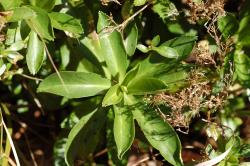- Taxon
- Gallery
- = Thlaspi oleraceum Poir. in Poiret, Encycl. [J. Lamarck & al.] 7, 547 (1806)
- = Nasturtium oleraceum Kuntze, Revis. Gen. Pl. 2, 937 (1891)
- = Lepidium oleraceum var. acutidentatum Kirk, Stud. Fl. New Zealand 35 (1899)
- = Lepidium oleraceum var. frondosum Kirk, Stud. Fl. New Zealand 34 (1899)
- = Lepidium oleraceum var. serrulatum Thell., Lepidium 293 (1906)
Glabrous perennial. Stems decumbent to erect, stout, usually flexuous, to 50 cm tall. Lvs all similar, narrow-oblanceolate to obovate, evenly toothed in distal portion, cuneately narrowed to winged petiole at base, bright green, fleshy, 2–10 × 1.5–4 cm. Racemes terminal and lateral, 5–10 cm long at fruiting; pedicels erecto-patent, (3)–5–10 mm long at fruiting. Sepals 1–1.5–(2) × 0.5–1 mm. Petals white, obovate-spathulate, slightly > to twice length of sepals. Stamens 4. Silicles broadly ovate, usually truncate at base, acute at apex, not winged, 3–4–(5) × 2.5–3.5–(5) mm; style 0.1–0.2 mm long; seeds ovoid, brown, not winged, 1.5–2 mm long.
[From: Webb et al. (1988) Flora of New Zealand. Volume 4.]
Flowering: (Jul.)–Dec.–Feb.–(Jun.); Fruiting: (Jul.)–Dec.–Feb.–(Jun.)




